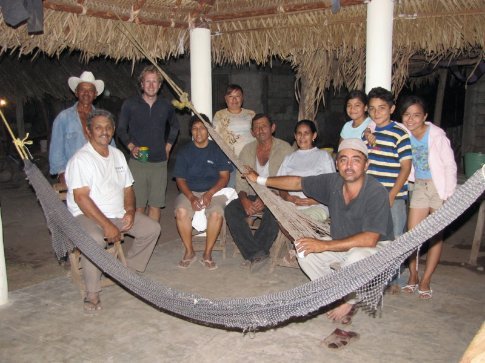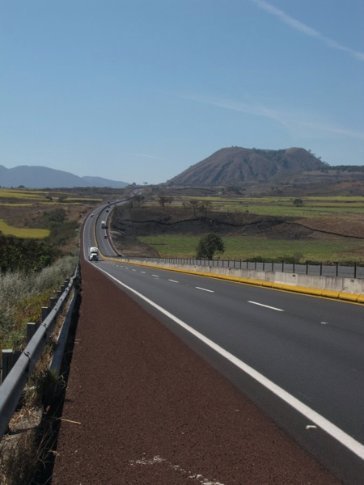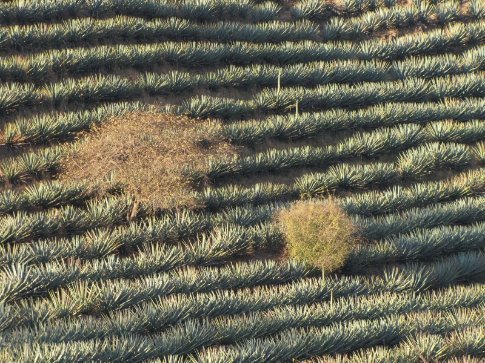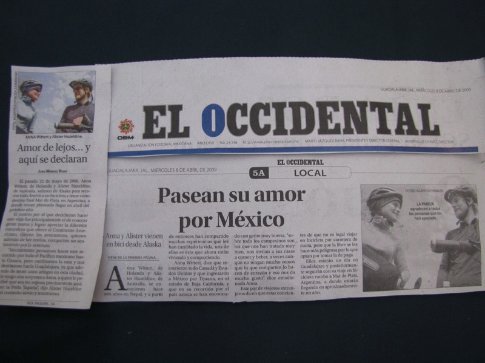30/3/09 - 7/4/09 Mazatlan to Guadalajara 534 km
After nearly two months off the bike, we saddled up and rode out of warm and sticky Mazatlan where we had enjoyed a tranquil time with our amiga Chamely and her puppy ‘Blitz’. Mazatlan itself was a stark contrast to the place it had been during carnaval a month earlier. The bikes felt good, and surprisingly we weren't too rusty either, spinning the wheels over to let our legs get into condition again. For the first few days at least it would be relatively flat along the coastal plain.
After an overnight stop in Escuinapa de Hidalgo, a bike crazy town with more bike repair shops you could poke a spoke at, good tacos and a cheap hotel we rode on to Teacapan and the ‘end of the road’. We rode past fields and fields of chiles and huge truckloads of workers busily picking and laying out the chiles to dry. We had heard from two other friends we had cycled with, Wayne and Thomas, that it would be possible to get a boat across the river to where the road begins again. We had also heard stories of an ‘unridable sandy road’ or having to ride 10 km along the beach (as Thomas and his brother had). After our local ‘can do’ guy, ‘sure i have a boat, i’ll take you across there in the morning, no worries’ failed to show we began our negotiations with a couple of local fisherman who agreed to take us across the river into Nayarit for a decent fee. The frigate birds scavenged on the small fish thrown away after the catch from the boat we were about to take, swooping like prehistoric birds. So with a hint of fish in the air, we took our bags off, laid our bikes down side by side and enjoyed the 15 minute cruise up the glassy river as dolphins rolled past, herons and egrets fished among the mangroves and cormorants perched to dry their wings.


On the other end of the trip in Nayarit we were welcomed at a restaurant. Within a few minutes they presented us with three plates of fresh local fried shrimp, fish and ‘papas fritas’ or hot chips. ‘es un regalo para ustedes!’.... a gift they said to welcome us to Nayarit. We couldn’t say no despite our feelings about sustainable fishing, and the fact that they wouldn’t join us but kept working hard around us while we ate. It’s the kind of generosity we got to experience a lot more in this part of Mexico.
The road turned out to be fine to the coast to Playa Novillero, then freshly sealed until just before a small ‘poblado’, Palma where the road turned to churned rock and then narrowed into a sandy track. At this point we became aware that our map was wrong and that the continuous line of our road was going to be interrupted by a large Rio (river). ‘So that’s what the old guy was telling us and drawing for us in the sand!’ we exclaimed. We were told that it was possible to take ‘una lancha’ (a small fishing boat) across the other side. ‘Only’ 4 kilometres they said, but we had to push our bikes in parts in the sand. The mosquitoes honed in on us slow moving targets in the humid tropical forest, and a dodgy guy in a pick-up truck tried to convince us for $50 US he’d take us across the river, and that would be the only way. This guys forcefulness in following us made us feel a little vulnerable on this lonely sandy track.
Just at the point we considered backtracking, we arrived at a fish camp with restaurants, small boats, hundreds of frigate birds and a few friendly faces. We soon had a small boat organised to take us over the wind chopped river to a road that we hoped existed. This boat was small and our bikes hung over the edges getting a salty spray from the ocean while we sat on fish bloodied seats, and crabs and fish lay at our feet. This was proving to be more of an adventure than we had bargained for. On the other side we asked where the road was. The two fisherman pointed towards the jungle of palms, ‘la carretera’....which translated means highway. It didn’t look like your average highway, but following the sandy two wheeled track through the palms, and more pushing of bikes we eventually found our way into the next village. Amazing that it was all possible.
We arrived into the next village tired and weary from an adventurous day. Anna asked in the local store if we could camp out the back somewhere as there were definitely no hotels. A lady in the store said that she lived across the road and we could set up our tent under a palapa in the backyard. It was perfect, three hammocks, the tent on the cement floor, chickens, pigs, mule and horses roaming the yard. Soon the whole family was there wanting to talk to us and ask us questions; daughters, sons, grandchildren, family friends, the whole lot. We feel their warmth and they have patience with our spanish, talking slowly, listening carefully.

The father of the house Aniseto came home after another hard day at work. He is a true cowboy ‘un vaquero’, weather beaten he arrives on his horse. He doesn’t say much, but i understand ‘su casa’ which means ‘my house is your house’ and he shakes our hands and sits there to listen to our stories. We are humbled by this experience, they have so little, yet are willing to share what they do have with strangers on bicycles. They also seem so relatively happy with their simple existence, working hard on the land to make enough money to put food on the table for their family and bring up their children. We think about them a lot the next day riding out of town.
Mexcaltitan is an island town set in the middle of a coastal lagoon and mangroves. We arrive by another small boat to this tranquil town where there are no cars, only bikes, carts, wheelbarrows and people walking the streets. Amazing the sounds of a place without the ambient noise of cars and trucks: children playing at school, the church bells and the sound of people going about their lives the way they have for hundreds of years. Shrimp tamales are the speciality here (a corn dough filled with shrimp, wrapped in corn husks and steamed) and the people sell them from their doors and from wheelbarrows.

On the other side of the lagoon we meet Luis, a local Mexican farmer also on his bike who wants us to ride with him the 20 kilometres to his house. We say we might slow him down, but he says ‘esta bien’. We ride together for over an hour talking in our limited spanish, he understands us and we understand him. There is also the common bond of the bicycle, his is a 20 year old fixed gear. Luis rides his bike every day of the year 20 kilometres to the boat dock for Mexcaltitan with 60 kilograms of fresh mango and papaya on a box on the back, sells his fruit, then returns the same way home. Again, a simple man, a simple life, 40 km on the bike everyday.

‘Les gusta ver mi casa?’ he asks. We join him along the cobblestone streets to his home to meet his family, and they share drinks with us and offer us food. Unfortunately we must keep riding for the day but are touched by the generosity of those that have so little, and give us so much.

In Santiago Ixcuintla, we finally make the decision that has been hanging over our heads for the past two months. We will head up into the hills and the central highlands towards Guadalajara instead of taking the pacific coast route. With that decided it’s time to climb the 900 metres to Tepic, firstly out of the tropical coastal lowlands of mango farms, where we sweat like mad, then onto the 15D toll road which climbs almost unrelentingly for another 30 kilometres. We definitely haven’t got our climbing legs back yet, but slowly we haul in the distance to reach the beautifully set city of Tepic, among cloud capped mountains. The plaza has a relaxed ambience with it’s white painted manicured trees, fountain, and rows of park benches . Huichol Indians sell their wares and jewelry at small street markets, shoe shiners work hard and women weave decorative palm leave crosses in front of the cathedral for Palm Sunday and the beginning of ‘Semana Santa’.

From Tepic we continue on the 15D toll road, safer (with a shoulder) and quieter than the free road (but not technically legal). Someone had a bright idea to lay thick red gravel on the shoulder of the road which made cycling extremely difficult, slowing our progress uphill and forcing us to brake hard on the long downhills to avoid skidding off the road. We wonder for what purpose it serves?... Our braking fingers are strained and we have to stop several times on the big hills. The toll road or ‘la cuota’ is designed for trucks and fast moving traffic and therefor through this mountainous and volcanic landscape the uphills are long and sustained sometimes 40 minutes to an hour of climbing, followed by ‘white knuckled’ steep descents in the red gravel.

This trend continues for the three days to Tepic, punctuated only by the toll booths which we have to get off and walk our bikes through and the oasis they provide of cool drinks in the heat. We pass several large volcanic mountains and cross their lava flows of black fractured igneous rock. It’s dry and it’s hot, a change from the tropical heat of the coast. At the base of the volcanoes, on rocky hillsides and the valley floor grow rows and rows of blue agave, a prickly succulent plant and the main ingredient for Tequila...

The turnoff for the town of Tequila takes us down 5 steep kilometres, great for the end of a hot day, not so great to think about the next morning retracing our steps. We take a tour of the Jose Cuervo Distillery in the centro of town to get an insight into the production of the national drink of Mexico. The blue agave is harvested at six years, all of the leaves are removed in the field and the ‘pina’ (literally ‘pineapple’) is dug out of the ground. It’s then oven roasted and shredded into ‘mosto’ (the juice) which is then fermented in large holding tanks for eighteen hours. It is then a sweet wine with a specific gravity reading of between 6 and 12 degrees. It then undergoes a distillation process, at least two or three times to extract the alcohol and create the final product. Some is bottled straight away as ‘Tequila blanca’, while most is barreled in oak barrels for a few weeks to six years depending on the type of product it is destined to become. Many of the good tequilas, 100% agave product, are sipping tequila, not the slammers we are used to. We sample six varieties, from the second distillation 55% alcohol, to the Tequila Anejo, ‘aged tequila’.

Interesting is the cultural importance of the mescal wine, first used by the indians of the region, and the beliefs that go along with it. Surprisingly we are still able to walk and aside from the large number of touristy shops, we find Tequila to have a really genuine mexican feel to it, beautiful plaza and cathedral, and great street food and tacos. What is great here is to see Mexicans on holiday and travelling in their own country....after all it is the home of Tequila!
Guadalajara is a huge city, five or six million people, the second largest in Mexico, and we had apprehensions about riding here at all. After receiving our first military checkpoint inspection (every other time they just waved us through), the roads became more congested, busy two lanes highway with trucks and pollution. We usually get a shot of adenalin riding in city traffic and this was no exception. Underpasses stop us, as do busy exit and entry lanes, sometimes stuck in an island of fast moving traffic, but we are soon into the more tranquil city streets passing parks, gardens and cathedrals on our way to meet up with our Japanese friends Nobu, Hiro and their friend Ken. It wasn’t as bad as had been expected except the ongoing construction and streetworks in the vicinity of the hotel. This morning we are in the city newspaper ‘el Occidental’, after being snapped on the highway out of Guadalajara by a journalist who wanted to hear our story. Once again, things always seem to get lost in translation and the headline is that i will ‘pop the question’ to Anna in Guadalajara.

Maybe one day our spanish will be such that we will be completely understood. For now it’s a couple of days of rest before heading south.
Que les vaya bien!
Adios
Alister and Anna